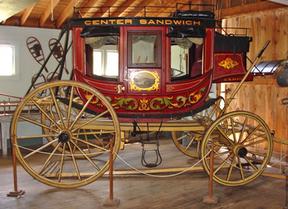The Concord Coach
 The Abbot-Downing story could have been written by 19th century popular novelist Horatio Alger, according to the Concord Historical Society’s Crosscurrents of Change: Concord, N.H., in the 20th Century. Lewis Downing, a wheelwright from Lexington, Mass., arrived in Concord on a mild May morning in 1818 with a set of tools and $60 in his pocket. Downing was “endowed with courage and optimism,” and made his first carriage for Benjamin Kimball. Downing prospered as a wheelwright, setting up a small factory that had more than a dozen employees. He joined forces with carriage builder J. Stephen Abbot in 1826, and the first Concord Coach was built in the following year.
The Abbot-Downing story could have been written by 19th century popular novelist Horatio Alger, according to the Concord Historical Society’s Crosscurrents of Change: Concord, N.H., in the 20th Century. Lewis Downing, a wheelwright from Lexington, Mass., arrived in Concord on a mild May morning in 1818 with a set of tools and $60 in his pocket. Downing was “endowed with courage and optimism,” and made his first carriage for Benjamin Kimball. Downing prospered as a wheelwright, setting up a small factory that had more than a dozen employees. He joined forces with carriage builder J. Stephen Abbot in 1826, and the first Concord Coach was built in the following year.
The coaches were tall and wide, custom made and individually numbered, weighing 2,500 pounds each. The big fitted wheels had spokes long enough to get through the mud and rutted roads of the young Republic. What made the coach particularly popular was its suspension, a pair of leather strips called “throughbraces” that held up the coach bodies and provided a characteristic rocking motion, far less jarring than coaches with steel springs.
Mark Twain, the author and humorist, described his coach trip west in the 1870 book Roughing it:
“Our coach was a great swinging and swaying stage, of the most sumptuous description – an imposing cradle on wheels. It was drawn by six handsome horses, and by the side of the driver sat the ‘conductor,’ the legitimate captain of the craft; for it was his business to take charge and care of the mails, baggage, express matter, and passengers. We sat on the back seat, inside. About all the rest of the coach was full of mail bags – for we had three days’ delayed mails with us… We changed horses every ten miles, all day long, and fairly flew over the hard, level road.”
The cost was between $1,000 and $1,500 apiece, a lavish sum when a worker considered a dollar a day a good wage. Coaches had separate models to carry six, nine and 12 passengers. Abbot-Downing’s biggest customer was Wells, Fargo & Co., although institutions such as hotels would buy one to carry guests back and forth from a railroad station.
Abbot-Downing survived into the 20th century, and in 1915, the manufacturer supplanted its horse-drawn products with trucks and fire trucks powered by internal combustion engines. The company stopped manufacturing after World War I and the name was purchased by Wells, Fargo.
Abbot-Downing vehicles may be coming home. In 2010, developer Stephen M. Duprey proposed locating several antique Abbot-Downing wagons and coaches in kiosks along downtown Concord sidewalks, the Concord Monitor reported on Oct. 18, 2012. Concord is redesigning a section of Main Street, financed in part by a $4.7 million federal grant, and officials have expressed hope that the coach-filled kiosks would attract visitors.
Links about the Concord Coach:
The Abbot-Downing Historical Society – http://concordcoach.org/
Wikipedia – http://en.wikipedia.org/wiki/Stagecoach#Concord_stagecoaches
Wells Fargo – https://www.wellsfargo.com/about/history/stagecoach/concord

